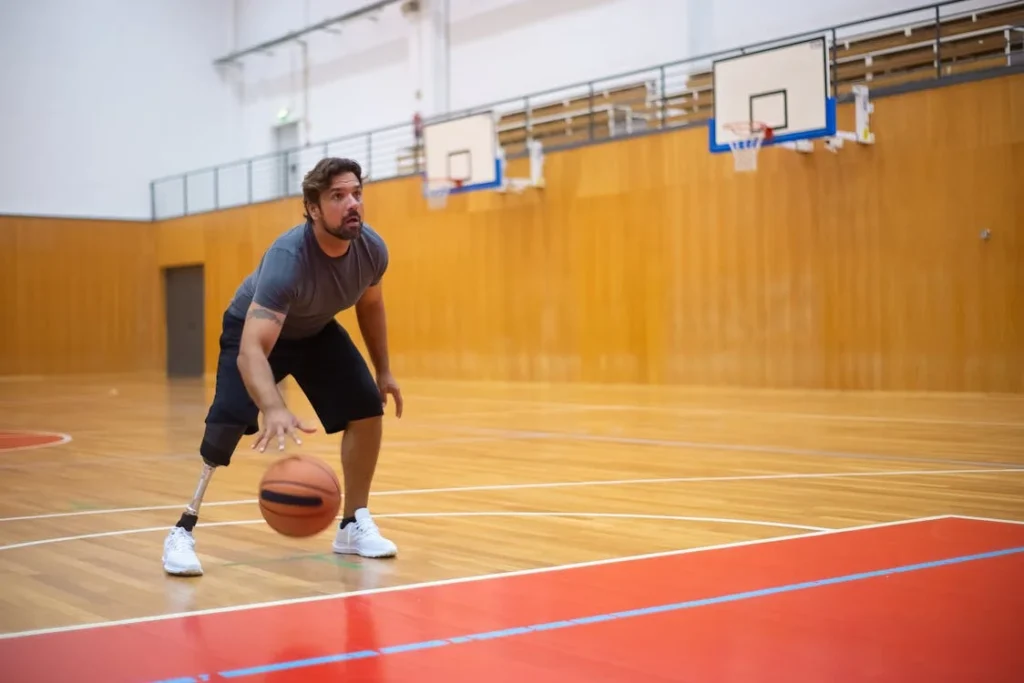For people with a partial foot amputation, staying active can be challenging without the right prosthetic foot. Whether you enjoy running, hiking, sports, or just staying on your feet for long hours, having a prosthetic that supports your movement is essential. Many prosthetic feet are designed for everyday walking, but high-activity amputees need something more—durability, flexibility, and energy return that allows them to move naturally and comfortably.
Advancements in prosthetic technology are making it easier than ever for partial foot amputees to live active lives. With lighter materials, better shock absorption, and dynamic footplates, modern prosthetics can restore confidence and mobility.
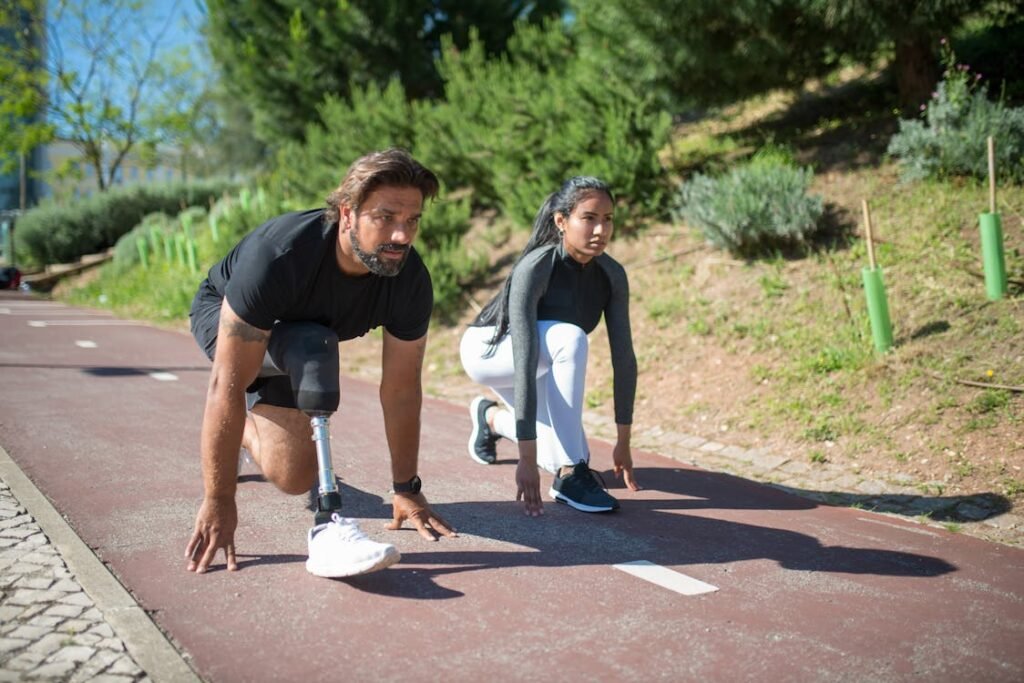
Understanding the Needs of High-Activity Partial Foot Amputees
Choosing the right prosthetic foot is not just about replacing what was lost—it’s about ensuring you can move the way you want. High-activity amputees require more than a basic prosthesis designed for slow walking or standing.
Whether you are an athlete, a fitness enthusiast, or someone who simply enjoys an active lifestyle, your prosthetic foot must keep up with your movement without causing discomfort or strain on the rest of your body.
The Importance of Energy Return and Shock Absorption
One of the biggest challenges for active partial foot amputees is maintaining efficiency while walking or running. A natural foot absorbs impact and transfers energy with every step, helping you move forward with minimal effort.
Many traditional prosthetic feet lack this feature, forcing users to expend extra energy and experience fatigue more quickly.
Modern high-performance prosthetic feet are designed with advanced materials like carbon fiber, which mimic the natural spring-like function of the foot.
These prosthetics store energy as the user steps down and release it when they push off, creating a more fluid and natural walking or running experience. This energy return is especially important for runners, hikers, and those who engage in high-impact activities.
Shock absorption is another crucial factor. Active users put a lot of stress on their prosthetic foot, which can lead to joint pain and discomfort if the device does not absorb impact effectively.
Newer prosthetic designs incorporate flexible footplates and cushioned heel systems to reduce strain on the residual limb, knees, and hips, allowing for smoother movement over various terrains.
Stability and Balance for Dynamic Movements
High-activity amputees often move in multiple directions, making quick turns, sudden stops, or explosive starts.
A good prosthetic foot must provide stability to prevent falls and reduce the risk of injury. Traditional prosthetic feet are often rigid and do not adapt well to uneven surfaces, but newer models are designed to handle complex movements with ease.
Prosthetic feet with split-toe designs or adaptive ankle joints allow for better grip and stability. These features help users navigate rough terrain, uneven ground, or high-impact activities like basketball or tennis.
A prosthetic foot that moves with the user instead of resisting their natural motion makes a significant difference in overall performance and comfort.
Lightweight Materials for Long-Term Use
The weight of a prosthetic foot can have a major impact on performance. A heavier device requires more energy to lift with each step, leading to faster fatigue.
High-activity prosthetic feet are often made from lightweight carbon fiber and titanium, providing durability without adding unnecessary weight.
A lighter prosthetic also means less strain on the residual limb, which can help prevent long-term complications like muscle imbalances or joint pain.
For individuals who spend hours on their feet or engage in endurance activities, a well-balanced, lightweight prosthetic foot is essential for maintaining mobility throughout the day.
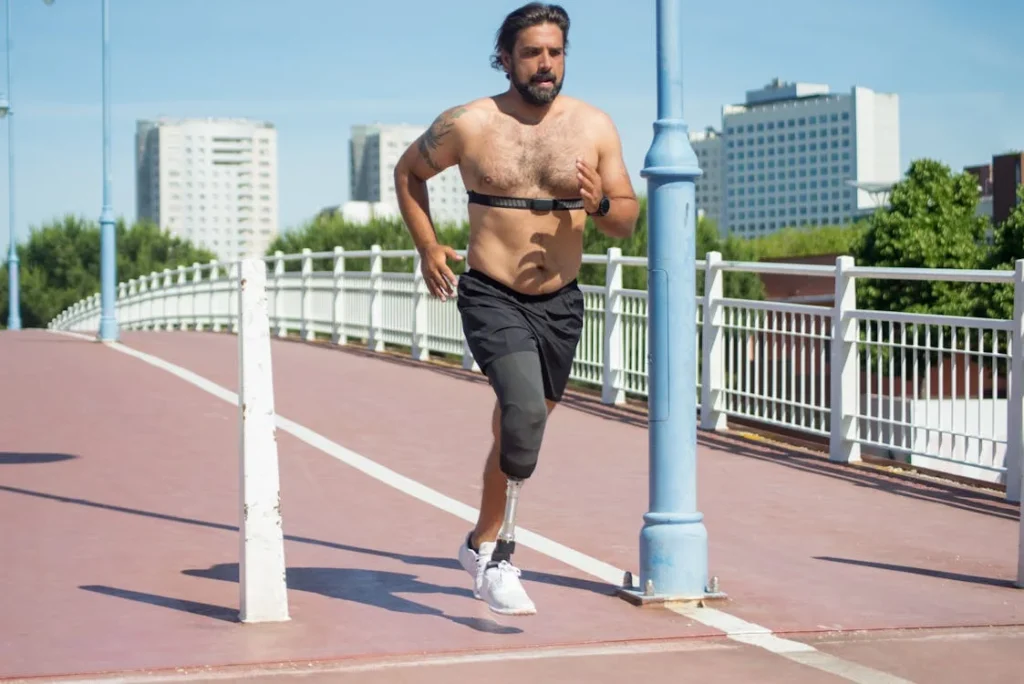
The Best Prosthetic Feet for High-Activity Partial Foot Amputees
With so many prosthetic options available, finding the right one for a high-activity lifestyle can feel overwhelming.
The best prosthetic foot for you depends on your level of activity, the type of movements you perform, and how much impact your prosthetic needs to withstand.
Thankfully, modern designs offer a range of features that cater specifically to active users, ensuring better comfort, performance, and durability.
Carbon Fiber Prosthetic Feet for Maximum Energy Return
One of the most significant advancements in prosthetic technology is the use of carbon fiber. This material is strong, lightweight, and flexible, making it ideal for high-performance prosthetic feet.
Carbon fiber feet store energy when the user steps down and release it upon push-off, creating a spring-like effect that reduces effort and enhances movement.
For runners, this means a more natural stride with less strain on the body. For those who engage in activities like hiking or sports, carbon fiber prosthetics offer better propulsion, allowing for quick direction changes and better control.
Unlike traditional rigid prosthetic feet, carbon fiber models adjust dynamically to different surfaces, improving balance and comfort.
Dynamic Response Feet for a Natural Walking and Running Experience
Dynamic response prosthetic feet are designed to replicate the natural movement of a foot by responding to the force exerted on them.
These feet provide a combination of flexibility, energy return, and shock absorption, making them ideal for people who move frequently throughout the day.
For high-activity amputees, a dynamic response foot ensures smoother transitions between walking, jogging, and sprinting. Instead of feeling like a stiff extension of the leg, these feet move in sync with the user’s motion, reducing strain on the residual limb and other joints.
Many models come with split-toe technology, allowing for better grip and control on uneven surfaces, which is particularly useful for outdoor enthusiasts and athletes.
Multi-Axial Feet for Stability on Uneven Terrain
For those who love hiking, trail running, or any activity that involves uneven ground, multi-axial prosthetic feet are a game-changer. Unlike traditional feet that only move in one direction, multi-axial feet can adapt to various angles and surfaces, preventing slips and missteps.
These prosthetics work by allowing motion in multiple planes, meaning they can adjust as the terrain changes. Whether you’re walking on a rocky trail, climbing stairs, or moving through unpredictable environments, multi-axial feet offer better traction and stability.
This makes them a preferred choice for those who need versatility in their prosthetic foot.
Waterproof and Sports-Specific Prosthetics
Many active amputees need prosthetic feet that can withstand exposure to water, sand, or extreme conditions. Waterproof prosthetics are designed for swimmers, surfers, and those who engage in water-based activities.
These prosthetic feet are made from corrosion-resistant materials, allowing users to transition from land to water without switching devices.
For sports enthusiasts, there are specialized prosthetic feet designed for high-impact activities like soccer, basketball, and cycling.
These prosthetics offer reinforced stability, shock absorption, and enhanced grip, ensuring optimal performance while minimizing the risk of injury.
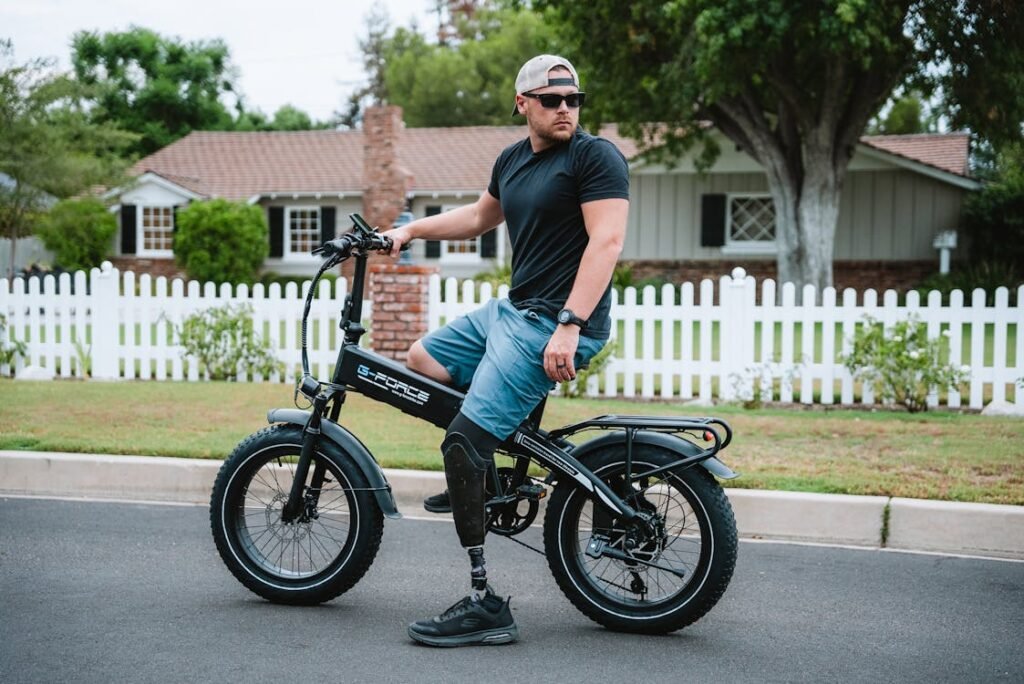
Choosing the Right Prosthetic Foot for Your Lifestyle
Finding the perfect prosthetic foot is not just about picking the most advanced model—it’s about choosing a foot that matches your unique lifestyle and activity level.
Every high-activity amputee has different needs, whether it’s running marathons, hiking in rugged terrain, or simply staying on their feet for long hours at work.
Understanding what to look for can help you make the best decision for long-term comfort and performance.
Matching Your Activity Level with the Right Features
Not all high-activity prosthetic feet are built the same. Some are designed specifically for athletes who need maximum energy return, while others focus on stability for those who navigate different terrains. Before making a decision, consider your daily routine.
If you are a runner, a prosthetic foot with carbon fiber technology will provide the best energy return, helping you move faster with less effort.
If you spend a lot of time on uneven ground, a multi-axial foot that adjusts to different surfaces will improve stability and reduce strain on your joints.
For those involved in water-based activities, a waterproof design will prevent damage while allowing you to move freely in wet environments.
Comfort and Fit for Long-Term Use
A prosthetic foot is only as good as its fit. Even the most advanced technology won’t feel right if the foot doesn’t align properly with your residual limb.
Custom-molded sockets and footplates ensure that your prosthetic integrates seamlessly with your body, reducing pressure points and discomfort.
The right fit also improves weight distribution, which is critical for high-activity users. If the prosthetic places too much pressure on one area, it can cause pain and lead to long-term joint issues.
Working with an experienced prosthetist to find the perfect fit will ensure you get the most out of your prosthetic foot.
Durability and Maintenance for Active Users
High-activity prosthetic feet endure more wear and tear than standard models, making durability an essential factor. Materials like titanium and reinforced carbon fiber ensure that the foot can withstand high-impact movements without breaking down quickly.
Regular maintenance is also crucial. Checking for wear and tear, replacing footplates when necessary, and ensuring all components are functioning properly will extend the lifespan of your prosthetic.
Many modern prosthetic feet are designed with interchangeable parts, allowing users to make quick adjustments without needing a full replacement.
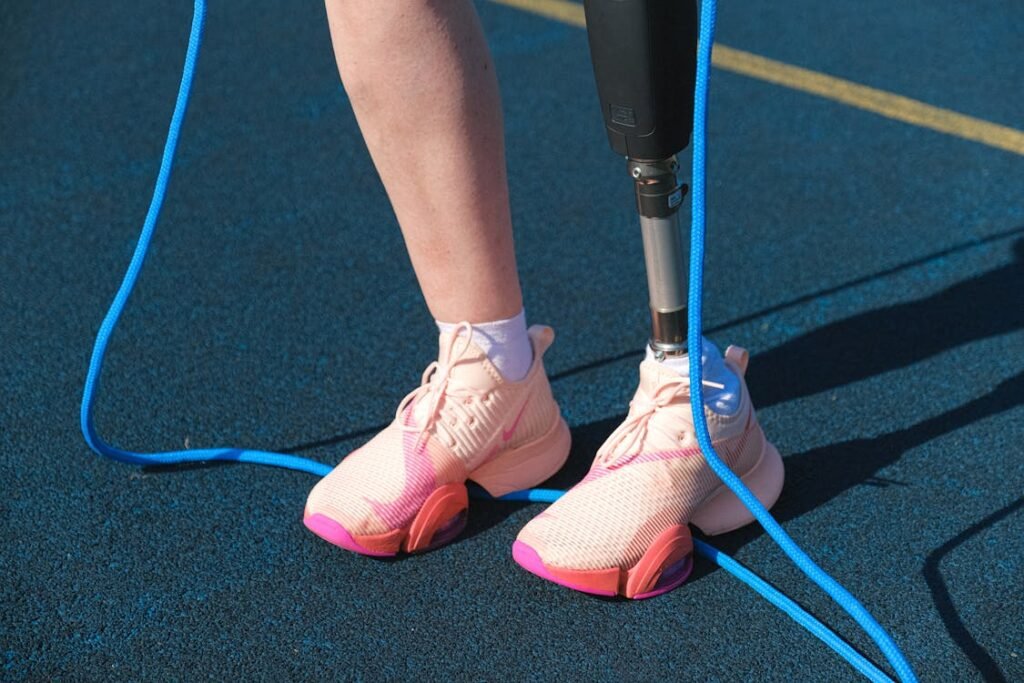
The Role of Technology in Enhancing Prosthetic Foot Performance
Prosthetic feet for high-activity amputees are becoming more advanced, thanks to innovations in materials, biomechanics, and artificial intelligence.
These advancements are not just improving mobility but also making prosthetics more intuitive, responsive, and adaptable to different activities.
Smart Prosthetics and Microprocessor-Controlled Feet
One of the most exciting developments in prosthetic technology is the introduction of smart prosthetic feet. These feet use embedded microprocessors to analyze walking patterns in real-time, adjusting stiffness, energy return, and ankle movement based on the user’s activity.
This means that whether you are walking on a smooth surface, climbing a hill, or sprinting, the prosthetic automatically adapts to provide better balance and efficiency.
Microprocessor-controlled feet are particularly useful for high-activity amputees who switch between different types of movement throughout the day.
Instead of relying on a static design, these prosthetics continuously optimize performance, reducing strain on the body and improving overall movement.
3D Printing for Customized Prosthetic Solutions
Customization plays a huge role in ensuring that a prosthetic foot meets the needs of an active user. 3D printing technology is making it easier and faster to create prosthetics that are perfectly tailored to an individual’s anatomy and activity level.
With digital scanning, prosthetists can design a foot that fits seamlessly with the user’s residual limb, improving comfort and reducing the need for frequent adjustments.
Beyond fit, 3D-printed prosthetic feet can be designed with specific features, such as enhanced grip patterns for trail running, lightweight structures for sprinting, or reinforced components for extreme sports.
This level of personalization ensures that amputees get a prosthetic foot that truly supports their lifestyle.
The Future of Prosthetic Innovation
The future of prosthetic foot technology is focused on making devices even more natural and efficient.
Researchers are developing bioengineered prosthetics that integrate directly with the nervous system, allowing users to control their foot movements with their brain, just like a biological limb.
Sensory feedback systems are also being explored, giving amputees the ability to “feel” the ground beneath them, improving balance and awareness.
These advancements will make prosthetic feet more intuitive and connected to the user’s body, allowing for greater freedom and confidence in movement.
With continued research and innovation, high-activity amputees will have access to even better prosthetic solutions that enhance their mobility, endurance, and overall quality of life.
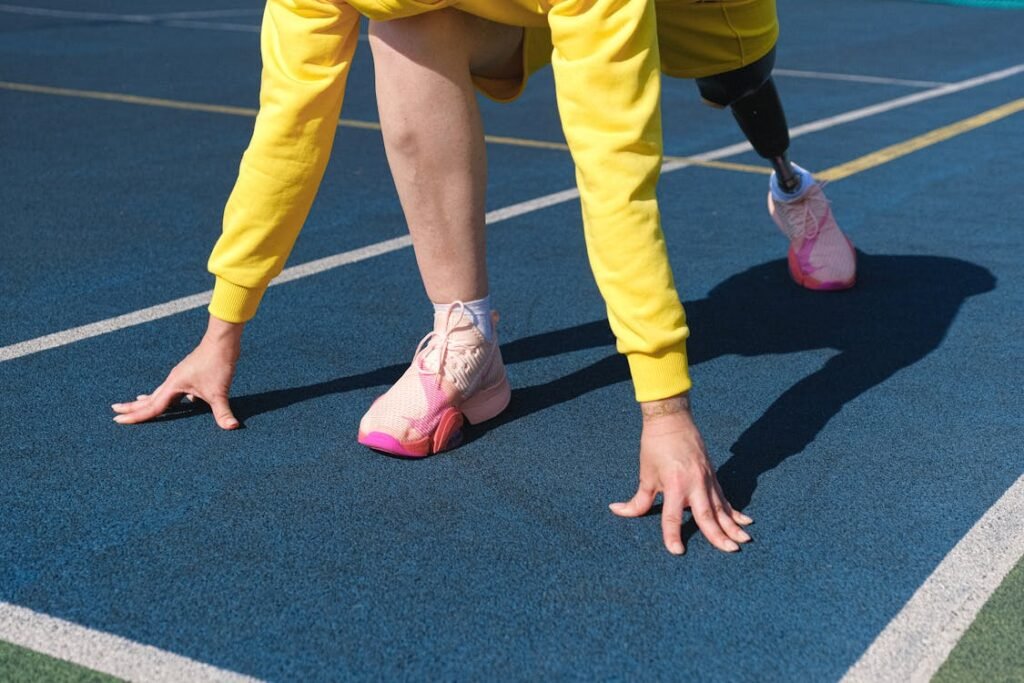
Overcoming Challenges with High-Activity Prosthetic Feet
While modern prosthetic feet offer incredible advancements, high-activity users still face unique challenges when it comes to durability, adaptability, and comfort.
Understanding these challenges and how to address them ensures that amputees can make the most of their prosthetic foot without limitations.
Managing Impact and Reducing Fatigue
High-impact activities like running, jumping, and hiking put significant stress on the prosthetic foot and the user’s residual limb.
Without proper shock absorption, this repeated impact can lead to discomfort, muscle strain, and even joint damage over time.
To address this, many prosthetic feet now incorporate built-in shock absorbers that reduce the force transferred to the limb with each step.
These systems use spring-loaded mechanisms, flexible footplates, or hydraulic dampening to create a smoother experience.
For users who engage in endurance sports, choosing a prosthetic foot with superior shock absorption can help prevent long-term injuries and reduce fatigue.
Preventing Skin Irritation and Pressure Sores
For high-activity amputees, wearing a prosthetic foot for extended periods can sometimes lead to skin irritation or pressure sores.
Excessive friction, heat buildup, and poor socket fit can all contribute to discomfort, making it difficult to stay active without pain.
The best way to prevent these issues is by ensuring a proper fit. Custom-molded sockets that distribute pressure evenly across the limb reduce the risk of developing pressure points.
Breathable, moisture-wicking liners also help regulate temperature and prevent sweat buildup, keeping the skin dry and irritation-free.
Regular maintenance of the prosthetic foot also plays a role in preventing skin problems. Ensuring that all parts are secure and functioning properly minimizes unwanted movement, reducing friction against the skin.
For high-activity users, checking the fit of their prosthetic regularly and making adjustments when needed can make a big difference in overall comfort.
Adapting to Different Terrains and Weather Conditions
Not all prosthetic feet perform well on every surface. A foot designed for sprinting on a track may not be ideal for rocky hiking trails or wet conditions.
High-activity amputees often need a prosthetic that can adapt to various terrains without compromising stability or comfort.
Multi-terrain prosthetic feet are designed to provide better traction and flexibility, allowing users to navigate different surfaces with confidence.
Some advanced models include adaptive ankle joints that adjust in real-time, providing better grip on slopes, stairs, and uneven ground.
Waterproof and corrosion-resistant materials are also essential for those who train or compete in all weather conditions, ensuring that the prosthetic remains functional in rain, mud, or snow.
Maintaining Long-Term Performance and Durability
Even the best prosthetic feet require maintenance to stay in top condition. High-activity users put their prosthetics through more wear and tear than average users, meaning regular inspections and servicing are crucial.
Replacing worn-out footplates, checking for loose components, and ensuring that shock absorption mechanisms are still effective can prevent sudden failures.
Many modern prosthetics are designed with modular components, allowing users to replace individual parts instead of the entire foot. This extends the lifespan of the device while keeping costs manageable.
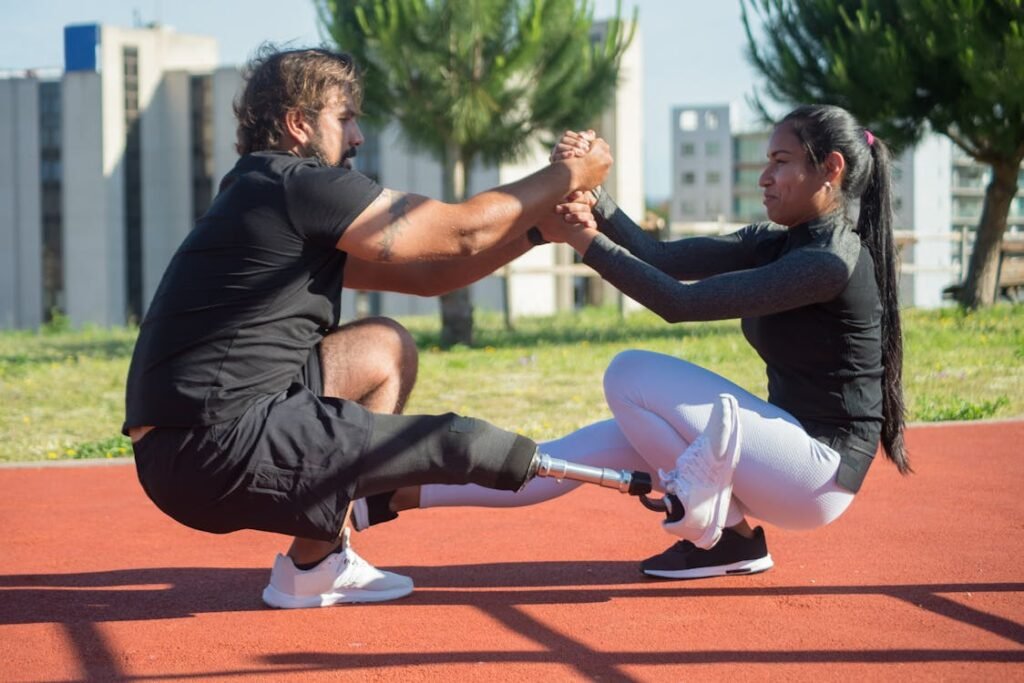
Enhancing Performance with Rehabilitation and Training
Even with the most advanced prosthetic foot, proper rehabilitation and training are essential for high-activity amputees.
Adapting to a new prosthetic, improving mobility, and maximizing performance all require practice and the right approach to training.
With modern rehabilitation techniques and targeted exercises, amputees can strengthen their bodies, improve balance, and move more naturally with their prosthetic foot.
Strengthening Muscles for Better Control
After a partial foot amputation, the muscles in the legs, hips, and core must work harder to compensate for the lost limb.
Without proper strengthening, users may experience imbalances that affect their walking or running efficiency.
Engaging in strength training exercises, especially those focused on the glutes, quadriceps, and core muscles, helps create a stable foundation for movement.
Exercises such as squats, lunges, and single-leg balance drills help reinforce proper gait mechanics.
Resistance training with bands or weights also builds endurance, reducing the risk of fatigue during high-impact activities. By strengthening the body, amputees can reduce strain on their prosthetic foot and move with greater ease.
Improving Balance and Coordination
Balance is one of the biggest challenges for high-activity amputees. The absence of a full foot changes the way weight is distributed, making it harder to maintain stability, especially on uneven terrain.
Practicing balance exercises improves control and reduces the risk of falls, allowing users to move with confidence.
Prosthetic users can benefit from stability drills, such as standing on a balance board or using a wobble cushion. Yoga and Pilates are also excellent for improving proprioception—the body’s ability to sense and adjust to movement. These exercises train the body to respond quickly to changes in terrain, enhancing agility and stability during high-intensity activities.
Adapting to Different Movements
Everyday walking and high-performance movements require different mechanics. High-activity amputees must train their bodies to adapt to the unique demands of their chosen sport or activity.
For runners, this means focusing on proper foot strike and stride efficiency. For hikers, it involves learning how to distribute weight evenly on rough surfaces.
Rehabilitation specialists can guide amputees through sport-specific training programs that target the skills they need. Practicing quick lateral movements, explosive starts, or uphill running techniques helps users develop better control over their prosthetic foot.
With consistent training, the prosthetic becomes a natural extension of the body, allowing for smoother and more efficient movement.
The Role of Gamified Rehabilitation
Advancements in rehabilitation are making training more engaging through gamification. Interactive exercises, virtual reality simulations, and AI-driven movement tracking are being used to help amputees refine their gait and movement patterns.
By turning rehabilitation into a game-like experience, users stay motivated while improving their prosthetic control.
For high-activity users, gamified rehabilitation can provide real-time feedback on their stride, impact forces, and balance.
These insights help them make necessary adjustments, improving efficiency and reducing strain on their bodies. The ability to track progress over time also keeps users motivated as they work toward their mobility goals.
Conclusion
For high-activity partial foot amputees, having the right prosthetic foot makes all the difference. With advancements in carbon fiber technology, dynamic response feet, and microprocessor-controlled designs, amputees can now enjoy better energy return, stability, and comfort. Whether it’s running, hiking, or engaging in high-impact sports, modern prosthetics provide the durability and flexibility needed to move with confidence.
Beyond technology, proper rehabilitation and training are crucial for maximizing performance. Strengthening muscles, improving balance, and adapting to different movements ensure that users get the most out of their prosthetic foot. With the rise of gamified rehabilitation and AI-driven training, amputees now have more tools than ever to refine their mobility and reduce strain on their bodies.
The future of prosthetic feet continues to evolve, with innovations that make prosthetics feel more natural and responsive. As technology advances and accessibility improves, more amputees will have the opportunity to lead active, unrestricted lives. By choosing the right prosthetic foot and investing in proper training, high-activity amputees can push their limits and achieve their goals without hesitation.



